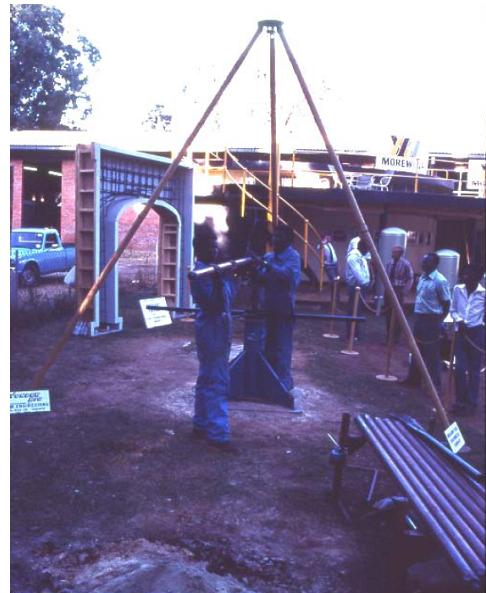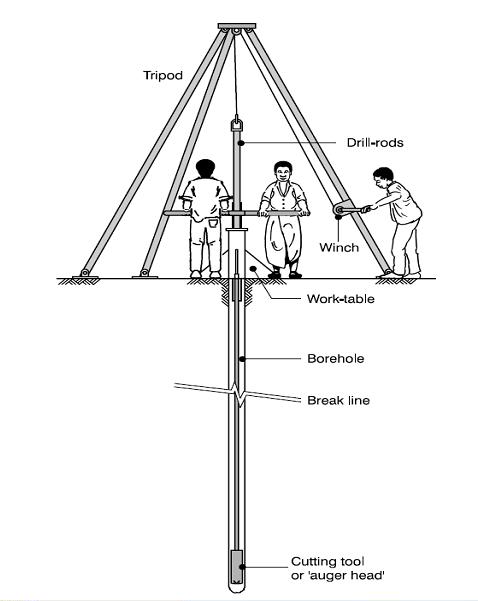Difference between revisions of "Hand auger - Vonder rig"
| Line 1: | Line 1: | ||
{{stub}} | {{stub}} | ||
[[Image:Treadle_pump_icon.png|right]] | [[Image:Treadle_pump_icon.png|right]] | ||
| + | [[Image:Work table and auger bit.jpg|thumb|right|300px|Work table and auger bit]] | ||
__NOTOC__ | __NOTOC__ | ||
| − | |||
The Vonder rig is a [[Hand auger - general|hand auger method]] method that uses a heavy tripod, a winch, and a working table. It has been used extensively in Zimbabwe and distributed widely in sub-Saharan Africa. The cutting tool (auger head) is rotated to cut into the ground, and then withdrawn to remove excavated material. This is repeated until the required depth is reached. | The Vonder rig is a [[Hand auger - general|hand auger method]] method that uses a heavy tripod, a winch, and a working table. It has been used extensively in Zimbabwe and distributed widely in sub-Saharan Africa. The cutting tool (auger head) is rotated to cut into the ground, and then withdrawn to remove excavated material. This is repeated until the required depth is reached. | ||
| Line 22: | Line 22: | ||
==Construction, operations and maintenance== | ==Construction, operations and maintenance== | ||
| − | [[Image: | + | [[Image:Diagram of a vonder rig.jpg|thumb|right|300px|Diagram of a vonder rig]] |
The Vonder rig makes use of a tripod and working table and is therefore more expensive than the conventional augering tools. However, use of the worktable and tripod ensure a straight borehole. | The Vonder rig makes use of a tripod and working table and is therefore more expensive than the conventional augering tools. However, use of the worktable and tripod ensure a straight borehole. | ||
Revision as of 06:04, 27 April 2012
| |
The Vonder rig is a hand auger method method that uses a heavy tripod, a winch, and a working table. It has been used extensively in Zimbabwe and distributed widely in sub-Saharan Africa. The cutting tool (auger head) is rotated to cut into the ground, and then withdrawn to remove excavated material. This is repeated until the required depth is reached.
The Vonder rig was developed in the early 80's and is manufactured in Zimbabwe.
Suitable conditions
The Vonder rig is suitable for unconsolidated formations: sand, silt and soft clay. Stiff clays, hard materials and gravels are difficult or impossible to drill through and to remove (unless augering is combined with percussion).
| Advantages | Disadvantages/limitations |
|---|---|
| - Vonder rig ensures a straight borehole | - Tools for vonder rig are more expensive than conventional hand augering tools
- Slow compared with other methods. |
Construction, operations and maintenance
The Vonder rig makes use of a tripod and working table and is therefore more expensive than the conventional augering tools. However, use of the worktable and tripod ensure a straight borehole.
Equipment is commercially produced by V&W engineering in Zimbabwe. Local production is possible.
Suppliers
- V&W Engineering Ltd, Zimbabwe (49 Leyland Road, P.O.Box 131,Harare). - Produces the Vonder rig.
- Van Reekum Materials, Netherlands - Drilling equipment, hand auger and percussion drilling - http://www.reekum.nl
- Eijkelkamp Agrisearch Equipment, Netherlands - Drilling equipment and manuals on hand auger and percussion gouges - http://www.eijkelkamp.nl
Costs
Field experiences
The vonder rig is widely used in Malawi, Kenya, South Africa and Zimbabwe.
Reference manuals, videos, and links
- Self-help wells, R.G. Koegel, FAO 1985. Internet manual on hydrogeology, well constructions, all drilling techniques - website.
- Human-Powered Drilling Technologies, Richard Carter, Cranfield University, 2005 - An overview of human-powered drilling technologies - Download.
- 'Private Sector Participation in Low Cost Water Well Drilling', Cranfield University, 2001. Article on private sector participation in low cost water well drilling in Africa. Download.
- Rural Water Supply Network - Useful network and website for information and downloads related to Rural Water Technologies - Hand drilled wells. General website.
- Drilling Boreholes for Hand pumps, Peter Wurzel, SKAT Switzerland, 2001 - A book on hydrogeology, well construction, drilling techniques, well development - Download. Website of SKAT
- Low-cost shallow tube well construction in West Africa, M. Sonau, FAO - An overview of shallow tube well drilling techniques - website. Website of FAO documents.
- Technical note 43. Simple drilling methods, Bob Elson and Rod Shaw, WEDC - An overview of simple drilling methods Download. Website of Loughborough University Technical Briefs section. Website of Loughborough University WELLS.
- A Water Handbook, Technical Guidelines Series, UNICEF, 1999 - Programming and implementation. Download.
- Technology notes, section 7; Tube wells and boreholes, WaterAid - An overview of human-powered drilling technologies. Download. Website of Wateraid.org.
- Water for the World, Technical note series rws 2, USAID 1982 - Technical notes on methods of developing of groundwater, manual drilling techniques. Website Livewater International.
- Multi-service procedures for well-drilling operations, field manual chapter 9, US Military Chapter 9, alternative well construction, manual drilling techniques - Download.
Acknowledgements
- The basis for the material on this page was obtained from a desk study shortly to be published on the website of the Practica Foundation, and from the Rural Water Supply Network, and specifically its manual drilling section.

|



